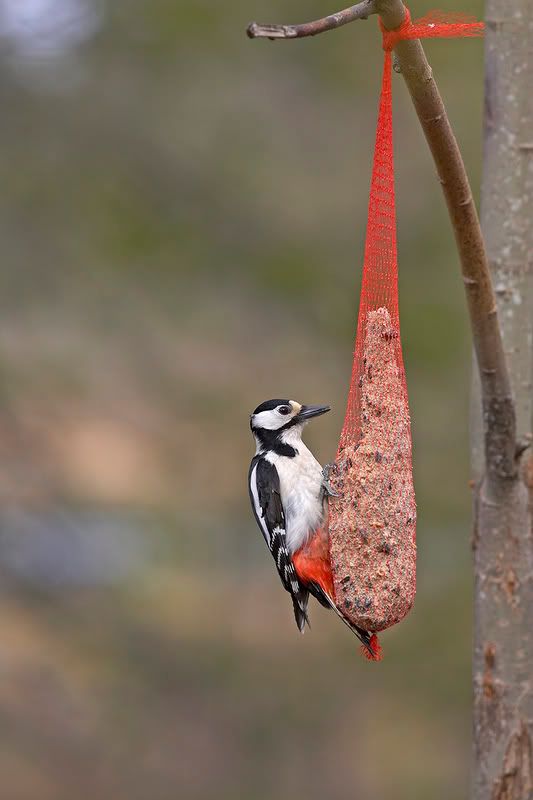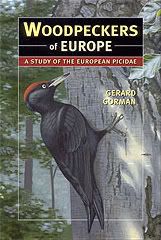 Woodpeckers can be helped in various ways. They can be encouraged to occupy, or remain in, an area in various ways. On a small scale garden owning birdwatchers can feed Great Spotted Woodpeckers and Syrian Woodpeckers with peanuts, seed, suet and fat, especially in winter when foraging is tough (The Great Spotted in this photo was taken by Jari Peltomaki in Oulu, Finland). Green Woodpeckers are attracted to lawns, golf courses and the like, which have not been treated with pesticides. In some countries Grey-headed Woodpeckers come into gardens, too, especially to feed on fat put out for them. As Wrynecks do not create their own holes, they need natural or old woodpecker cavities in which to nest and roost and they can suffer when trees containing holes are removed for "health and safety" or other reasons. This species will readily accept suitably placed nest-boxes. Great Spotted and Green Woodpeckers will also use nest-boxes, but on the whole the best policy for these species as regards nesting sites is to provide suitable trees in which the birds can excavate their own cavities. All in all, landowners, workers and gardeners should refrain from “tidying-up” hedges and trees, leaving some standing dying or dead wood for woodpeckers to open up in search of insect prey. Town councils should be encouraged to resist tidying up parks, verges and lanes, unless a clear safety hazard exists. Deadwood and mature timber should be left and felling resisted.
Woodpeckers can be helped in various ways. They can be encouraged to occupy, or remain in, an area in various ways. On a small scale garden owning birdwatchers can feed Great Spotted Woodpeckers and Syrian Woodpeckers with peanuts, seed, suet and fat, especially in winter when foraging is tough (The Great Spotted in this photo was taken by Jari Peltomaki in Oulu, Finland). Green Woodpeckers are attracted to lawns, golf courses and the like, which have not been treated with pesticides. In some countries Grey-headed Woodpeckers come into gardens, too, especially to feed on fat put out for them. As Wrynecks do not create their own holes, they need natural or old woodpecker cavities in which to nest and roost and they can suffer when trees containing holes are removed for "health and safety" or other reasons. This species will readily accept suitably placed nest-boxes. Great Spotted and Green Woodpeckers will also use nest-boxes, but on the whole the best policy for these species as regards nesting sites is to provide suitable trees in which the birds can excavate their own cavities. All in all, landowners, workers and gardeners should refrain from “tidying-up” hedges and trees, leaving some standing dying or dead wood for woodpeckers to open up in search of insect prey. Town councils should be encouraged to resist tidying up parks, verges and lanes, unless a clear safety hazard exists. Deadwood and mature timber should be left and felling resisted.On a larger scale foresters can do much to conserve woodpeckers and their habitats. Stands of trees used regularly by woodpeckers for breeding or feeding should be left unlogged for as long as possible. If this is not practical then at least the most frequented individual trees in a woodland should be spared the chain-saw. Wherever and whenever possible dead wood or rotting timber should be left alone and the pruning of healthy trees also avoided. In forest monocultures, such as conifer plantations, a few faster growing deciduous species (such as birch) should be left and/or planted to provide some diversity.
In areas where forests are heavily fragmented ecological corridors linking patches of forest should be maintained. In all forests woodpeckers create cavities and those trees with woodpecker created holes should be spared the chain saw, not only for the sake of the woodpeckers but for he benefit of all birds and other wildlife that use them. In the case of Black Woodpecker holes (which are used by other wildlife species) this may be crucial to the survival of secondary cavity nesters. Foresters should be encouraged to set-aside and spare trees with holes. Such conservation measures should concentrate on living trees with holes as these are the ones that foresters may be tempted to select and fell. In areas with few dead trees the protection of living trees with holes may well determine whether or not Jackdaws, Stock Doves and various owls live there or not.
Where woodpeckers have expanded their ranges into suburban areas the single most important factor for successful breeding is a supply of suitable trees. To this end old and decaying trees need to be retained in built-up areas.





No comments:
Post a Comment